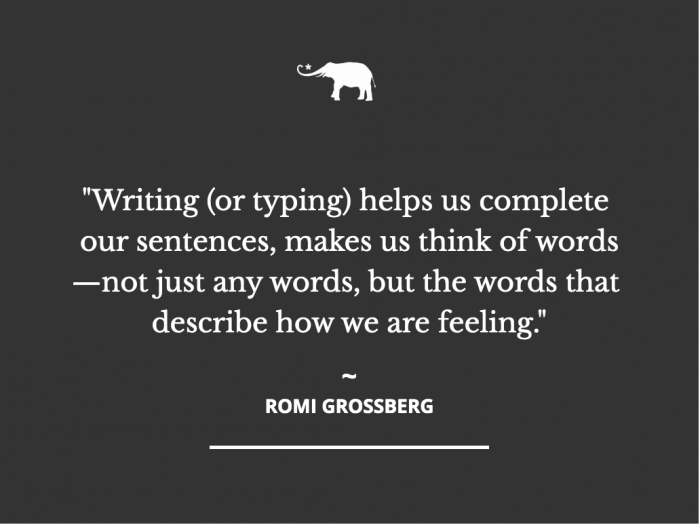I started writing in a journal when I was eight years old.
It was pink with unicorns and had a little lock and key that I hid in my underwear drawer. I didn’t have a particular purpose; I just knew I had too much in my head, and it needed to get out. I wrote every day.
Now I am 46. I still journal, and it stills help me find my words, process my emotions, and remove them from my busy mind to a safe place on the paper. I am lucky that in my profession I get to teach others the same. But it’s not always easy. Often, when I ask “Do you journal?” or “Do you want to try some writing therapy?” I am met with blank stares and a silent, “Seriously?”
Let me explain why the answer is, “Yes, I am serious.”
For those yet to discover journaling, are apprehensive about it, or basically think it’s a whole lot of bullsh*t, let me try a different tact.
Imagine we all have a whirlpool swirling just above our heads. Inside are our thoughts. Half thoughts, full thoughts, bits of memories, a couple points from the to-do list, an annoyance from earlier on, a flashback to something last year, a millisecond of feeling we’ve forgotten something, a worry about something next week, a nanosecond from a recent dream, some uncertainty about the future, mixed with the shopping list and what’s for dinner.
These thoughts, memories, and fears flash jump, sink and disappear, reappear, whirl and swirl until we are not sure if we have remembered or done anything today, and all we know is that we feel overwhelmed, stressed, anxious, and can’t quite focus.
So how can journaling help?
Now imagine a funnel that runs from this whirlpool above our heads straight to our hands and into the pen. Now obviously we can’t write 20 things at once, so luckily, this funnel is just the right size to deliver us one thought at a time. Just one.
And if it is a half-thought, a flash of something, or an “I don’t really know what this” thought, we start with a couple of words or maybe a sentence. Just one. A complete sentence. Easy because our brain isn’t satisfied with a half sentence, and so we will naturally finish it—finish the sentence, finish the thought, make sense of what it is. Then another sentence. And if we want—another. Until that particular thought has reached its conclusion. Now the next thought can slide down the funnel. One at a time.
None of this is a particularly conscious decision. All we have to do is grab our journal or a pen and paper and do some subconscious writing, free-flow writing, or pen-to-paper-see-what-happens writing.
It doesn’t matter how we phrase it; it is all the same; it is any writing we do without censoring ourselves.
The whirlpool will whirl, the funnel will do its job, and the pen will see us to the other end when that thought no longer needs our attention. The whirlpool will be empty, the mind feels clear, and our chest can relax in to some nice, deep breaths.
I say pen and paper because the forward momentum, rocking nature, and flow of pen on paper helps us to move through thoughts. These days, though, many people who grew up on computers and phones say they can achieve the same flow on technology because their typing is as fast as their brain (mine is certainly not, and I enjoy the flow of the pen).
Whether we are being fully intentional or completely unintentional, the writing (or typing), the act of it, will still do its job. We naturally become more thoughtful and precise when we write. If I were to verbally ask, “How are you today?” You might say, “I am good, I’m okay, not bad, a bit stressed, I’m fine.” You might say it without focus, caught up in the background noise, the broken record of the mind. But if I asked you to write down how you are today, chances are you would not simply write “I am good” and leave it there. A more descriptive word or a longer sentence or maybe even a paragraph may come out. Maybe it starts with, “A bit stressed,” and an (unintentional) paragraph later, we understand why we are stressed and possibly what we can do to relieve that stress.
The “free-flow” may take us to today’s stress then flip to an old story, or a future worry—that’s what free-flow does; it starts with just a word and allows our hands to do the rest.
Writing (or typing) helps us complete our sentences, makes us think of words—not just any words, but the words that describe how we are feeling.
Once we have identified how we are feeling, we can address that particular emotion, find a way to process it, move through, and heal. One word at a time. One thought at a time.

No comments:
Post a Comment